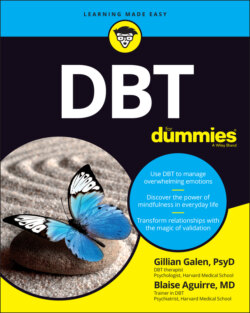Читать книгу DBT For Dummies - Gillian Galen - Страница 106
Understanding physical responses and conscious feelings
ОглавлениеEmotions are neurological phenomena that occur in response to a trigger event. The trigger could be an interaction with another person, a sight, a sound, a smell, a thought, or just about anything. Once the emotion has occurred, it causes us to take action. Every emotion is activating and hard-wired as a part of our evolutionary biology. This is so that when we experience an emotion or feeling, we act. Here are some examples:
Thirst tells us that we need to hydrate, and so it activates us to find water to drink.
Hunger tells us that our body is short on fuel and to find food to eat.
Fear tells us that there is a threat in the environment and to find safety.
Extreme temperature tells us that we are about to overheat or freeze and to find shade or warm clothes.
Fatigue tells us that our body needs rest and to slow down and get some sleep.
Emotions are mediated by various brain circuits. Emotional states have two distinctive components:
A pattern of characteristic physical responses: Emotional physical states are the responses of our hormones, muscles, heart, bladder, stomach, and so on.
A conscious feeling: Conscious feelings are the thoughts we have that are associated with the situation.
When we’re frightened, for instance, we not only feel afraid but also undergo unconscious body changes such as an increase in heart rate and respiration, dryness of the mouth, muscle tension, and sweaty palms. The conscious part of the experience consists of the thoughts we have about the situation.
In DBT, therapists work with the patient to connect the specific reactions and thoughts the patient has to the emotions they are experiencing. By mapping these out, they help the patient more easily recognize the emotions with a goal of realizing the automaticity of typical responses and the ideal of developing a greater repertoire of behavioral reactions. We review the impact of emotions and what to do with them in Chapter 10.
